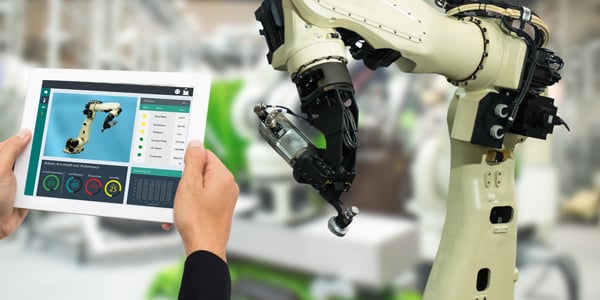An ongoing challenge for the manufacturing industry is to reduce waste. But how can you do so realistically? ‘Waste’ can be tangible - like stock material, ingredients or excess product. ‘Waste’ can also be intangible - like the time operators spend waiting for machines and the time it takes for products (raw and finished) to travel along the supply chain.
A combination of agile and Lean manufacturing processes coupled with e-commerce can effectively reduce waste. Let’s discuss how.
What is Lean manufacturing?
Lean manufacturing is about reducing waste and providing customers with more value - using fewer resources in the process. That could be reviewing the movement of raw and finished goods to reduce unnecessary transportation. Or it could be improving manufacturing process efficiency to reduce product defects and enhance overall product quality.

What is agile manufacturing?
While Lean concepts focus on waste reduction, agile principles are about ensuring businesses can quickly respond to market demands and address customer expectations. In the manufacturing space, Lean is usually the predecessor to agile.
The four pillars of agile manufacturing are:
- Modular product design to allow for quick and easy variation
- Technology to facilitate cross-team collaboration and quick data dissemination
- Alliances with corporate partners to enhance time to market
- A forward-thinking company culture that encourages knowledge sharing (which will support rapid changes within the business)

Achieve the above and you’ll find it easier to meet and exceed customer expectations.
Combine Lean and agile manufacturing principles and you can benefit from:
- Improved process efficiency
- A more productive workforce
- Enhanced cost efficiency
- Better customer service
- Ability to respond and adapt more quickly to change
The last benefit is particularly important for manufacturers. The less waste your business produces, the more resource-efficient you can be. The more resource-efficient you are, the more resources you can spare when it comes to addressing sudden changes in the market - e.g. fluctuations in demand, new regulations requiring a change to working conditions etc.
You get the picture.
Where does e-commerce come in?
Now, the two manufacturing principles (Lean and agile) can apply to processes beyond production and ensure your business is efficient across the board. This is where e-commerce comes in to lend its support.
An e-commerce platform can ensure your product, service and pricing information is stored in one location. This makes it easier for your teams to keep this information up-to-date as they don’t have to waste time searching for what to update (and where).
It also contributes to customer experience as your customers can easily find the information they’re looking for and always view an accurate, most up-to-date version. That means they don’t need to reach out to your sales or customer service team for assistance, giving them more autonomy and time back to your team. Time to spend on other value-adding tasks.
Here are a few solutions which can improve your e-commerce experience:
- PIM solution - to ensure efficient product information management (PIM). A PIM system ensures your product info is centralised, making its management easier (among other benefits)
- CMS - your website is your business’s digital shop window. A Content Management System (CMS) ensures any content you display is the best it can be - from your latest promotions and sales messaging to the most popular products/services
- CRM solution - to ensure your customer relationship management (CRM) process is streamlined. A CRM system houses all of your essential customer data in one place, making it easier for your teams to find and access what they need, when they need it
- AI - to analyse customer behaviour and offer intelligent recommendations based on the findings. This can help you better profile your customers and offer personalised engagements to boost customer experience
Can you see how e-commerce can support the pillars of agile manufacturing?
For starters, you would be adopting technology to facilitate cross-team collaboration and quick data dissemination. As your product information, website content and customer data are centralised, this enables your team to quickly find and update what they need. And work off the same version rather than passing multiple versions around.

This supports another pillar - knowledge sharing.
When your CRM and commerce platforms are integrated, you can easily personalise content on your digital storefront based on customer behaviour - not guesswork. So, you can design a website that actually converts.
And here’s another example: if your commerce platform is integrated with your ERP, you can benefit from reduced manual work. Payment and shipping details, web orders etc can all feed into the ERP system from your commerce. And warehouse stock levels can transfer from your ERP into your commerce.
That links to arguably the greatest benefit of all - you gain time back because:
- There’s no need to manually enter data
- Your customers can see an accurate update of your products (no pesky post-purchase emails of ‘whoops! Your product is now out of stock!’)…
- …which means they don’t need to contact your team so they can focus on other tasks
- Any orders placed via your website can be automatically processed through your ERP and be ready to ship…
- …which reduces time to market (another agile manufacturing pillar!)
Manufacturers, it’s time to create or rethink your e-commerce strategy
It shouldn’t come as a surprise that all markets are becoming more saturated - particularly for the manufacturing industry. After all, 70% of manufacturers worldwide say that increased competition is a key driving force behind their business’s digital transformation.
To keep up with market demands and trends, you must start adopting Lean and agile principles. E-commerce is a great area to explore if you haven’t already. Our guide to e-commerce for manufacturers covers everything you need to know.
And if you’re already part of the e-commerce game, well, there’s always room to improve. Right?
Check out our guide below for tips on the ideal e-commerce strategy for manufacturers.

